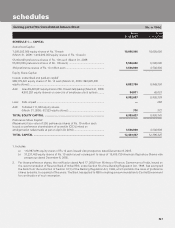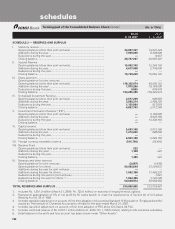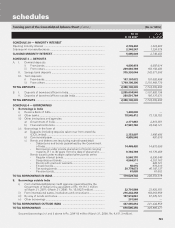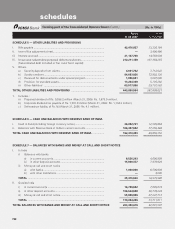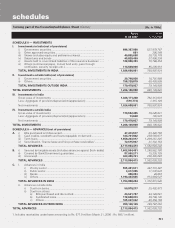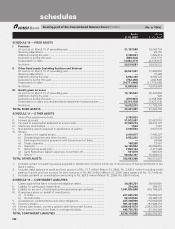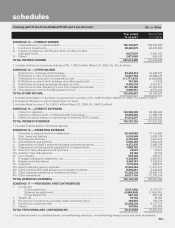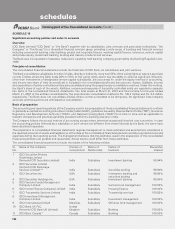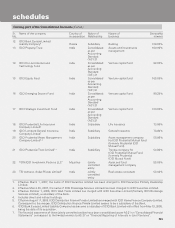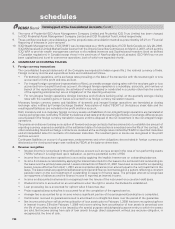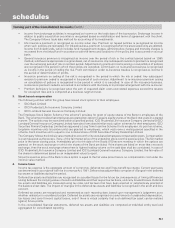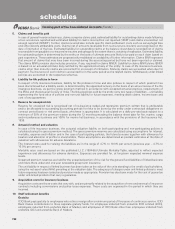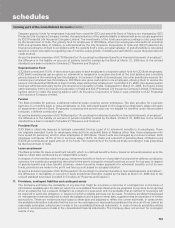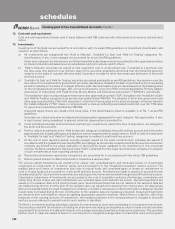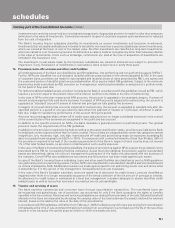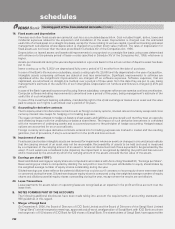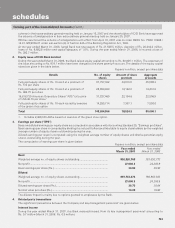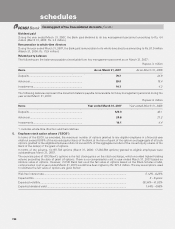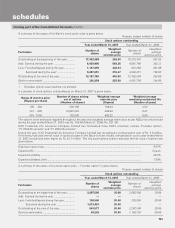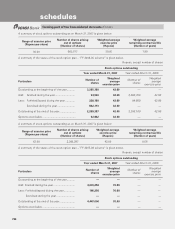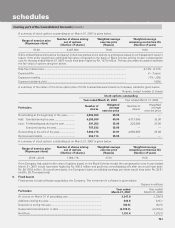ICICI Bank 2007 Annual Report Download - page 127
Download and view the complete annual report
Please find page 127 of the 2007 ICICI Bank annual report below. You can navigate through the pages in the report by either clicking on the pages listed below, or by using the keyword search tool below to find specific information within the annual report.
F57
schedules
• Income from brokerage activities is recognised as income on the trade date of the transaction. Brokerage income in
relation to public issues/other securities is recognised based on mobilisation and terms of agreement with the client.
The Company follows trade date method for accounting of its investments.
• Life insurance premium is recognised as income when due. Premium on lapsed policies is recognised as income
when such policies are reinstated. For linked business, premium is recognised when the associated units are allotted.
Income from linked funds, which includes fund management charges, administrative charges and mortality charges is
recovered from the linked fund in accordance with the terms and conditions of the policy and is accounted on accrual
basis.
• General insurance premium is recognised as income over the period of risk or the contract period based on 1/365
method, whichever is appropriate on a gross basis, net of service tax. Any subsequent revision to premium is recognised
over the remaining period of risk or contract period. Adjustments to premium income arising on cancellation of policies
are recognised in the period in which the policies are cancelled. Commission on re-insurance business is recognised
as income in the period of ceding the risk. Profit commission under re-insurance treaties is recognised as income in
the period of determination of profits.
• Insurance premium on ceding of the risk is recognised in the period in which the risk is ceded. Any subsequent
revision to premium ceded is recognised in the period of such revision. Adjustment to re-insurance premium arising
on cancellation of policies is recognised in the period in which it is cancelled. In case of life insurance business,
re-insurance premium ceded is accounted in accordance with the treaty or in-principal arrangement with the re-insurer.
• Premium deficiency is recognised when the sum of expected claim costs and related expenses exceed the reserve
for unexpired risks and is computed at a business segment level.
3. Stock based compensation
The following entities within the group have issued stock options to their employees.
• ICICI Bank Limited
• ICICI Prudential Life Insurance Company Limited
• ICICI Lombard General Insurance Company Limited
The Employee Stock Option Scheme (“the scheme”) provides for grant of equity shares of the Bank to employees of the
Bank. The scheme provides that employees are granted an option to acquire equity shares of the Bank that vests in a graded
manner. The options may be exercised within a specified period. ICICI Prudential Life Insurance Company Limited and ICICI
Lombard General Insurance Company Limited have also formulated similar stock option schemes for their employees. ICICI
Securities Primary Dealership Limited has approved a Long Term Incentive Scheme for its employees. As per this scheme,
long-term incentive units (incentive units) are granted to employees, which vests over a vesting period specified in the
scheme. Each incentive unit is equal to one notional share of ICICI Securities Primary Dealership Limited.
The Company follows the intrinsic value method to account for its stock-based employees compensation plans. Compensation
is cost measured as the excess, if any, of the fair market price of the underlying stock over the exercise price. The fair market
price is the latest closing price, immediately prior to the date of the Board of Directors meeting in which the options are
granted, on the stock exchange on which the shares of the Bank are listed. If the shares are listed on more that one stock
exchange, then the stock exchange where there is highest trading volume on the said date shall be considered. In case of
ICICI Prudential Life Insurance Company Limited and ICICI Lombard General Insurance Company Limited, the fair value of
the shares is determined based on an independent valuer’s report.
Since the exercise price of the Bank’s stock option is equal to the fair value price there is no compensation cost under the
intrinsic value method.
4. Income taxes
Income tax expense is the aggregate amount of current tax, deferred tax and fringe benefit tax charge. Current year taxes
are determined in accordance with the Income-tax Act, 1961. Deferred tax adjustments comprise of changes in the deferred
tax assets or liabilities during the period.
Deferred tax assets and liabilities are recognised on a prudent basis for the future tax consequences of timing differences
arising between the carrying values of assets and liabilities and their respective tax basis, and carry forward losses. Deferred
tax assets and liabilities are measured using tax rates and tax laws that have been enacted or substantively enacted at
the balance sheet date. The impact of changes in the deferred tax assets and liabilities is recognised in the profit and loss
account.
Deferred tax assets are recognised and reassessed at each reporting date, based upon management’s judgement as to
whether realisation is considered certain. Deferred tax assets are recognised on carry forward of unabsorbed depreciation,
tax losses and carry forward capital losses, only if there is virtual certainty that such deferred tax asset can be realised
against future profits.
In the consolidated financial statements, deferred tax assets and liabilities are computed at individual entity level and
aggregated for consolidated reporting.
forming part of the Consolidated Accounts (Contd.)


